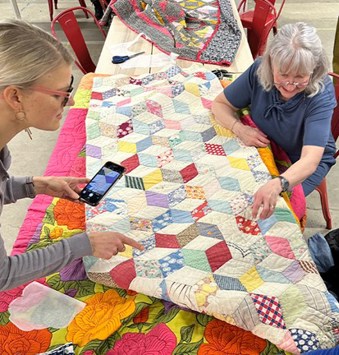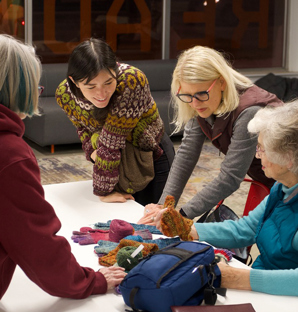
Fostering a Culture of Repair at Seed Lab
May 01, 2023
Seeding Repair workshops are a series of programs on repairing, upcycling and object fixing, along with the sharing of how-to skillsets. Hosted monthly at Seed Lab, these hands-on sessions promote a culture of mending and help remind all of us that low-cost repairs help the climate as the carbon footprint of buying a new item is avoided. Textile artist Amy Meissner often leads these workshops, offering demonstrations and assistance with repairs.
By Amy Meissner, Artist and Repair Practitioner
When you arrive at 5:30 pm for a textile repair workshop hosted by the Anchorage Museum’s SEED Lab, you’ll be invited to choose a seat at one of many tables beside folks of all ages and skill levels. “Regulars” will scooch over and ask what you’ve brought to mend, while the enthusiasm of newcomers ensures you’re soon sharing the stories behind your garments’ rips or holes, and why you feel they’re worth fixing. Others may confirm your hope. As one of three teachers who together lead garment and textile repair at the SEED Lab, I often feel this monthly workshop series runs on an engine of pure joy, support, and curiosity. Fellow teachers Jamie Hirano and Ming Stephens each bring a different personality and skill set to the craft act of repair, but inherent in us all is a fondness for materials, tools, making, creative problem solving, and an interest in teaching our community how to prolong the lives of its garments.
More participants trickle in while we thread sewing machines, plug in the iron, open shared bins filled with cloth, needles, fabric scissors, and rulers. Some folks carry bulging bags of mending, others arrive project-less, hoping to “just watch and learn” or to find kindred spirits who tackle mending piles as forms of personal fulfillment or climate activism.
 Jamie, Ming, and I utilize this first hour to meet with participants, assessing and advising on as many projects as we can: socks with holes, ripped pockets, shredded knees, blown out elbows, and those mysterious tiny holes that appear on the fronts of t-shirts are always on deck. Technical repairs such as zippers, fur, or welded seams on outdoor gear are more time-consuming and/or require more specialized materials or equipment than what we have available, but we always provide ideas for where to begin or who to turn to for professional help.
Jamie, Ming, and I utilize this first hour to meet with participants, assessing and advising on as many projects as we can: socks with holes, ripped pockets, shredded knees, blown out elbows, and those mysterious tiny holes that appear on the fronts of t-shirts are always on deck. Technical repairs such as zippers, fur, or welded seams on outdoor gear are more time-consuming and/or require more specialized materials or equipment than what we have available, but we always provide ideas for where to begin or who to turn to for professional help.
"Sometimes the affirmation, “Yes, this can totally be repaired, I’d do it like this …” is all a person needs to seek next steps."
At 6:30 pm, we aim an overhead camera at a teacher’s set of hands to project a tutorial onto a large screen. The three of us teach together, answer questions, and provide hands-on support for the next two hours. Monthly themes have included sashiko denim repair, darning, patching, and quilt mending, but we’ve also introduced low-waste sewing projects focused on reuse, such as making cloth shopping bags or reusable gift wrap from donated or on-hand fabrics.
The average American throws away 82 pounds of textile waste each year, contributing to a total of over 11 million tons of mostly non-biodegradable clothes in U.S. landfills. “Fast fashion” and overconsumption is partly to blame, but so is lack of knowledge: How do you care for wool? Thread a sewing machine? Sew a button? Reinforce a seam? Patch a knee? Fill a hole on the heel of your sock?
"In the past, these basic maintenance skills were either explicitly taught or central within the home, but society’s lack of connection to the act of making further disconnects us from the potentiality of repair."
The reasons and opportunities for repair vary. We identify with our belongings, which accompany us daily in tender, intimate ways.
 The first impulse to repair comes from the desire to prolong this relationship whether rooted in need, use value, or nostalgia. With various resources available online, there are many ways to self-teach, which is a great place to begin. Repair in community; however, generates an opportunity to share why repairing a certain item is important, or describe how it arrived at brokenness in the first place. Hearing stories, seeing many types of repairs, learning from others, sharing tools, and gaining one’s own set of skills to perhaps teach another someday fosters a culture of repair.
The first impulse to repair comes from the desire to prolong this relationship whether rooted in need, use value, or nostalgia. With various resources available online, there are many ways to self-teach, which is a great place to begin. Repair in community; however, generates an opportunity to share why repairing a certain item is important, or describe how it arrived at brokenness in the first place. Hearing stories, seeing many types of repairs, learning from others, sharing tools, and gaining one’s own set of skills to perhaps teach another someday fosters a culture of repair.
The marks left by the repairer’s hand, even if nearly invisible, provide a narrative of intention and long-term keeping for a generation we may never meet. They are our message of care to the future.
Seed Lab is open to the public during scheduled programming. Click here to see upcoming events. Interested in being an innovator or creative-in-residence for Seed Lab? Email your bio, a project idea or need, and how it would connect to Seed Lab’s priorities of climate + future: seed@anchoragemuseum.org.